The BSA MODEL 12/15 TARGET RIFLE
In the Parker-Hale 1935 catalogue, the rifle is introduced as the "
B.S.A. - PARKER MODEL 12/15".
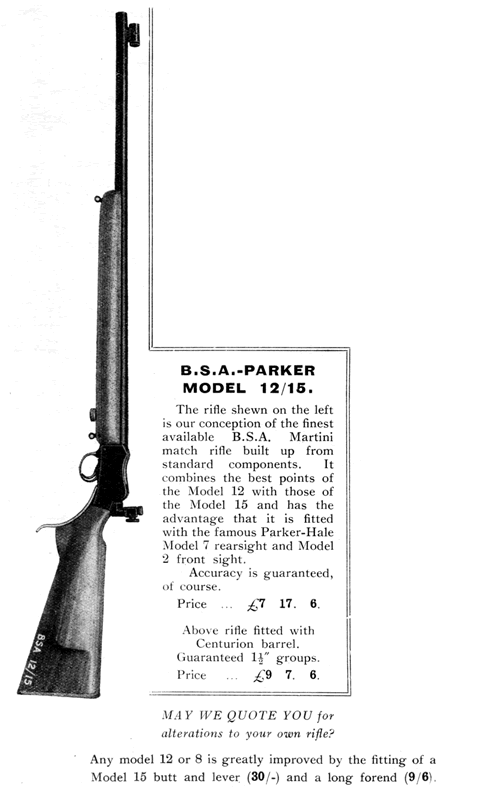 In
1940, the year following the commencement of the Second World War, the Society of Miniature Rifle
Clubs were still offering the familiar range of .22 RF Martini actioned
target rifles for sale; these included the oldest conversion of the full-bore
Martini service rifle, now in the form of the Parker-Hale
CMT2, the Vickers Jubilee and
Empire Models, Parker-Hale's
'Dewarifles' and the ubiquitous BSA Models Nos. 12, 15, and here illustrated
12/15.
In
1940, the year following the commencement of the Second World War, the Society of Miniature Rifle
Clubs were still offering the familiar range of .22 RF Martini actioned
target rifles for sale; these included the oldest conversion of the full-bore
Martini service rifle, now in the form of the Parker-Hale
CMT2, the Vickers Jubilee and
Empire Models, Parker-Hale's
'Dewarifles' and the ubiquitous BSA Models Nos. 12, 15, and here illustrated
12/15.
Also then present was the BSA Model
13, in the company of the bolt-actioned Model
1 and Model 2 rifles, which three
were advertised as suitable for use by Preparatory Schools and youth target
shooting.
Renovated War Office
Pattern minature rifles were made available, and the long-standing
conversion of the still in service S.M.L.E. - the .22RF (rimfire)
No.1 Mk.III - was, for obvious reasons, making something of a comeback,
either as freshly converted brand-new B.S.A No.1 Mk.III rifles, or as 'Parkerifled' conversions of service rifles.
Imported target and sporting rifles were still advertised, although expensive.
Winchesters formed the back-bone of such stock; namely the Winchester
52 with Marksman stock, heavy barrel and speed-lock mechanism, or
the heavier Bull-barrel Model, plus the Model 75 and Model 677 with scope.
The Mossberg M35 ended the list of then available target-shooting related
rifles.
Many small-bore rifles have been drawn into service in times of war,
occasionally for quite unusual tasks although, in the main, basic training
and, of course, latterly Home Guard use, were the most common official
duties between 1939 and 1945. Such rifles as were present with their owners
at Home Guard parades, in common with shotguns, also played a significant
part in putting food on the table in times of strict rationing and considerable
austerity. (See Winchester
auto rifles).
Within months, the availability of firearms for civilian purposes had
been brought to a rapid and dramatic close. Indeed, no small-bore rifles
would again be made publicly available until well after the war. The notably
slender 1945 edition of the Parker-Hale catalogue (no doubt prepared during
1944 whilst the outcome and time of conclusion of the War were still less
than certain elements) offered not a single rifle, solely ancillaries
were available.
The company declared, on the inside front page, that:
As a compromise between the wide demand for
our catalogues and the paper shortage, this abridged edition has been
compiled from our Service, Sporting and Small-bore Sections which were
previously printed separately. When conditions permit these sections will
appear in their original form.
In presenting this catalogue we have endeavoured,
for the convenience of our customers, to list only those articles which
are at present available, or can be obtained from time to time. However,
it will be readily appreciated that any publication of a similar type
issued during wartime conditions can only be a general guide to both the
items and the prices advertised therein, owing to constantly diminishing
supplies and increasing costs.
Matters had improved somewhat by the time Parker-Hale issued their next
catalogue available to us, that of 1947, although rationing of many commodities
was to continue into the 1950s. The frontispiece now noted:
Second Post War Catalogue
1947
In our first post war catalogue
issued in 1946, we had to deplore the deficiencies in supplies of available
goods and the uncertainty both as regards materials and prices.
Unfortunately, in the interval,
conditions have not much improved and at the time of writing, raw materials
are in shorter supply than ever, whilst rifles and sporting arms are bespoken
for months ahead, leaving none available for gunsmiths to exhibit.
Fortunately, as regards Service
rifle shooting, which can be said to be the most interesting of the sport
of marksmanship, the Government have released supplies of the new No.
4 Mark 1 Service rifles, and we have also secured good supplies of
the No. 3 (Pattern '14 Enfield rifle)
which are both reliable target weapons.
.303" Service rifle ammunition
is available in large quantities at cheaper rates than ever previously
obtainable.
Rifle Ranges are also readily available to Rifle Clubs affiliated to the
National Rifle Association whose Offices are at Bisley Camp, Brookwood,
Surrey.
Anyone interested in forming
a Service Rifle Club should write the Secretary, of the N.R.A. at the
above address.
It has been proved beyond doubt that the value of rifles in modern warfare
has in no sense diminished as a result of the increasing use now being
made of the machine-gun and machine carbine. On the contrary, a German
report intercepted during the North African campaign admitted that the
deadly accuracy of Australian riflemen was a constant menace to their
troops. It is not generally recognised that these Australians were previously
members of civilian rifle clubs, who took up marksmanship for its sporting
interest and were practically self taught.
Furthermore, it is generally recognised that marksmanship reaches its
peak in the art of the rifleman, and that maximum efficiency in the use
of heavier and automaticweapons can best be attained through preliminary
rifle training.
It is therefore with the conviction
that we are filling a National need that we present this catalogue devoted
to rifles and the care of rifles, together with the best devices and aids
for the training of riflemen.
It has not proved possible to ascertain for certain, details of pre-war
production quantities and serial numbering of the BSA Model 12/15.
We suspect that it is likely that some rifles without
the 'P' prefix are hybrids, especially since British gunmakers, particularly
Parker-Hale, were known to offer upgrading of earlier rifles, to a similar
specification to that of the 12/15, by adding the long fore-end, pistol
grip butt-stock and also by changing such internals as were necessary
to complete the conversion; e.g. the under-lever. Both A.J. Parker and
Parker-Hale offered all the spares necessary in their catalogues; thus
any enterprising and competent shooter could embark on this work.
John Knibbs, in his excellent reference book "The
Golden Century - a hundred years of BSA manufacture"-(see Recommended
Reading), reports that 13,260 Model No. 12/15 rifles were sold by
B.S.A. up to the 'last' leaving the factory in late 1951 - all within
the serial range P60001 to P 73260. However, a further reference is made,
at the end of chapter 15, noting that a further 5,396 rifles were despatched
in the three and a half years following on from November 1951, with the
last serial number being P76006. He then confirms, in a later chapter,
that a total production of 18,662 was achieved over an eight year period,
from which one would infer an end to final production in 1955 (remember
that post-war production recommenced in 1947). We have received details
from at least two readers who possess Model 12/15 rifles with late serial
numbers; the highest of these to date is P74895. If the believed total production of over
18,000 is added to the first known serial number, then serial numbers
exceeding P78000 should theoretically be possible. Disregarding the forced
break during the War years, the rifle was actually in production, in one
form or another, over a minimum of a sixteen year period. What has yet
to be determined is the starting serial number around 1935 and detail
of how pre-war rifle production filled the number-set between that and
60,000, if indeed it was part of that series.
Do you have the latest known off the production line?
Let us know at Miniature-Calibre-Rifles@Rifleman.org.uk
In the Parker-Hale 1935 catalogue, the rifle is introduced as the " B.S.A. - PARKER MODEL 12/15".
 In
1940, the year following the commencement of the Second World War, the Society of Miniature Rifle
Clubs were still offering the familiar range of .22 RF Martini actioned
target rifles for sale; these included the oldest conversion of the full-bore
Martini service rifle, now in the form of the Parker-Hale
CMT2, the Vickers Jubilee and
Empire Models, Parker-Hale's
'Dewarifles' and the ubiquitous BSA Models Nos. 12, 15, and here illustrated
12/15.
In
1940, the year following the commencement of the Second World War, the Society of Miniature Rifle
Clubs were still offering the familiar range of .22 RF Martini actioned
target rifles for sale; these included the oldest conversion of the full-bore
Martini service rifle, now in the form of the Parker-Hale
CMT2, the Vickers Jubilee and
Empire Models, Parker-Hale's
'Dewarifles' and the ubiquitous BSA Models Nos. 12, 15, and here illustrated
12/15.
Also then present was the BSA Model 13, in the company of the bolt-actioned Model 1 and Model 2 rifles, which three were advertised as suitable for use by Preparatory Schools and youth target shooting.
Renovated War Office Pattern minature rifles were made available, and the long-standing conversion of the still in service S.M.L.E. - the .22RF (rimfire) No.1 Mk.III - was, for obvious reasons, making something of a comeback, either as freshly converted brand-new B.S.A No.1 Mk.III rifles, or as 'Parkerifled' conversions of service rifles.
Imported target and sporting rifles were still advertised, although expensive. Winchesters formed the back-bone of such stock; namely the Winchester 52 with Marksman stock, heavy barrel and speed-lock mechanism, or the heavier Bull-barrel Model, plus the Model 75 and Model 677 with scope. The Mossberg M35 ended the list of then available target-shooting related rifles.
Many small-bore rifles have been drawn into service in times of war, occasionally for quite unusual tasks although, in the main, basic training and, of course, latterly Home Guard use, were the most common official duties between 1939 and 1945. Such rifles as were present with their owners at Home Guard parades, in common with shotguns, also played a significant part in putting food on the table in times of strict rationing and considerable austerity. (See Winchester auto rifles).
Within months, the availability of firearms for civilian purposes had been brought to a rapid and dramatic close. Indeed, no small-bore rifles would again be made publicly available until well after the war. The notably slender 1945 edition of the Parker-Hale catalogue (no doubt prepared during 1944 whilst the outcome and time of conclusion of the War were still less than certain elements) offered not a single rifle, solely ancillaries were available.
The company declared, on the inside front page, that:
As a compromise between the wide demand for our catalogues and the paper shortage, this abridged edition has been compiled from our Service, Sporting and Small-bore Sections which were previously printed separately. When conditions permit these sections will appear in their original form.
In presenting this catalogue we have endeavoured, for the convenience of our customers, to list only those articles which are at present available, or can be obtained from time to time. However, it will be readily appreciated that any publication of a similar type issued during wartime conditions can only be a general guide to both the items and the prices advertised therein, owing to constantly diminishing supplies and increasing costs.
Matters had improved somewhat by the time Parker-Hale issued their next catalogue available to us, that of 1947, although rationing of many commodities was to continue into the 1950s. The frontispiece now noted:
Second Post War Catalogue 1947
In our first post war catalogue issued in 1946, we had to deplore the deficiencies in supplies of available goods and the uncertainty both as regards materials and prices.
Unfortunately, in the interval, conditions have not much improved and at the time of writing, raw materials are in shorter supply than ever, whilst rifles and sporting arms are bespoken for months ahead, leaving none available for gunsmiths to exhibit.
Fortunately, as regards Service rifle shooting, which can be said to be the most interesting of the sport of marksmanship, the Government have released supplies of the new No. 4 Mark 1 Service rifles, and we have also secured good supplies of the No. 3 (Pattern '14 Enfield rifle) which are both reliable target weapons.
.303" Service rifle ammunition
is available in large quantities at cheaper rates than ever previously
obtainable.
Rifle Ranges are also readily available to Rifle Clubs affiliated to the
National Rifle Association whose Offices are at Bisley Camp, Brookwood,
Surrey.
Anyone interested in forming
a Service Rifle Club should write the Secretary, of the N.R.A. at the
above address.
It has been proved beyond doubt that the value of rifles in modern warfare
has in no sense diminished as a result of the increasing use now being
made of the machine-gun and machine carbine. On the contrary, a German
report intercepted during the North African campaign admitted that the
deadly accuracy of Australian riflemen was a constant menace to their
troops. It is not generally recognised that these Australians were previously
members of civilian rifle clubs, who took up marksmanship for its sporting
interest and were practically self taught.
Furthermore, it is generally recognised that marksmanship reaches its
peak in the art of the rifleman, and that maximum efficiency in the use
of heavier and automaticweapons can best be attained through preliminary
rifle training.
It is therefore with the conviction that we are filling a National need that we present this catalogue devoted to rifles and the care of rifles, together with the best devices and aids for the training of riflemen.
It has not proved possible to ascertain for certain, details of pre-war production quantities and serial numbering of the BSA Model 12/15.
We suspect that it is likely that some rifles without the 'P' prefix are hybrids, especially since British gunmakers, particularly Parker-Hale, were known to offer upgrading of earlier rifles, to a similar specification to that of the 12/15, by adding the long fore-end, pistol grip butt-stock and also by changing such internals as were necessary to complete the conversion; e.g. the under-lever. Both A.J. Parker and Parker-Hale offered all the spares necessary in their catalogues; thus any enterprising and competent shooter could embark on this work.
John Knibbs, in his excellent reference book "The Golden Century - a hundred years of BSA manufacture"-(see Recommended Reading), reports that 13,260 Model No. 12/15 rifles were sold by B.S.A. up to the 'last' leaving the factory in late 1951 - all within the serial range P60001 to P 73260. However, a further reference is made, at the end of chapter 15, noting that a further 5,396 rifles were despatched in the three and a half years following on from November 1951, with the last serial number being P76006. He then confirms, in a later chapter, that a total production of 18,662 was achieved over an eight year period, from which one would infer an end to final production in 1955 (remember that post-war production recommenced in 1947). We have received details from at least two readers who possess Model 12/15 rifles with late serial numbers; the highest of these to date is P74895. If the believed total production of over 18,000 is added to the first known serial number, then serial numbers exceeding P78000 should theoretically be possible. Disregarding the forced break during the War years, the rifle was actually in production, in one form or another, over a minimum of a sixteen year period. What has yet to be determined is the starting serial number around 1935 and detail of how pre-war rifle production filled the number-set between that and 60,000, if indeed it was part of that series.
Do you have the latest known off the production line? Let us know at Miniature-Calibre-Rifles@Rifleman.org.uk

Above is an " as marketed" example of the Post WWII Model 12/15, with the Parker-Hale No.7a rear sight, which permitted cleaning of the barrel without need of the sight's removal ( a design shared with the Vickers Martini "Perfection" rear-sight) and the PH No.2 tunnel fore-sight with interchangeable sight elements permitting quick alteration of post height or ring diameter; the only non-standard addition here being the Parker-Hale ten round "Quickloader" ammunition block to facilitate rapid fire.
This particular ammunition block is the second pattern, the "QL2",
and affixes, without gunsmithing, to the action securing pin. The alloy block's
split lug locates behind the knurled knob of the action pin.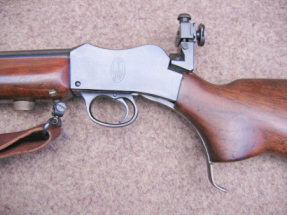
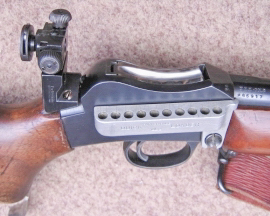 single-shot rifle still shows the
single-shot rifle still shows the
colour case-hardening either side of the groove of the loading slide.
The BSA "Piled Arms" motif is stamped on the LHS of the action
side plate. The aperture rear-sight of the 12/15 is still virtually a
retro-fit, although a standard item when the rifle first went into
production post-war in 1946/47.
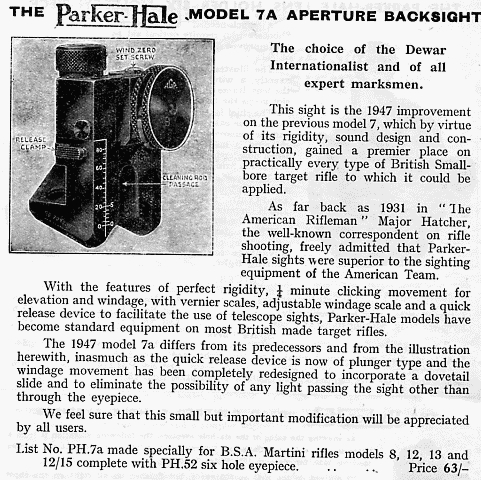 There is no longer a barrel-mounted tangent leaf rear-sight as had been fitted
There is no longer a barrel-mounted tangent leaf rear-sight as had been fitted 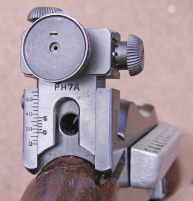 to the basic Model No.6, Model No.8,
to the basic Model No.6, Model No.8,
Model No.12 and early Model No.13 rifles.
The rear-sight used was the Parker-Hale Model 7A.
The Model 12/15 rifles were, at least from 1947, given serial
numbers prefixed wth the letter "P",
which makes them easily identifiable.
A corresponding dealer and enthusiast from the U.S.A. believes
he has had 12/15 rifles, in the 60,000 range, pass through his hands with
serial numbers not so prefixed. We're less convinced on this one; however,
we wouldn't be so pedantic as to deny any possibility - to do so in such circumstances
is usually a mistake. 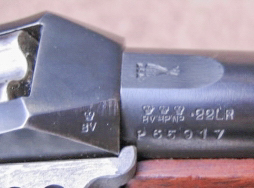 In common with most early Martini actions, the trigger on the 12/15 was not
adjustable other than by careful fettling of the sear and bent engagement. Removal
of too much material would reduce the height to which the action block would
be raised for loading. It was quite possible, with the stoning away of only
a few thousand's of an inch, to render the chamber impossible to load.
In common with most early Martini actions, the trigger on the 12/15 was not
adjustable other than by careful fettling of the sear and bent engagement. Removal
of too much material would reduce the height to which the action block would
be raised for loading. It was quite possible, with the stoning away of only
a few thousand's of an inch, to render the chamber impossible to load. 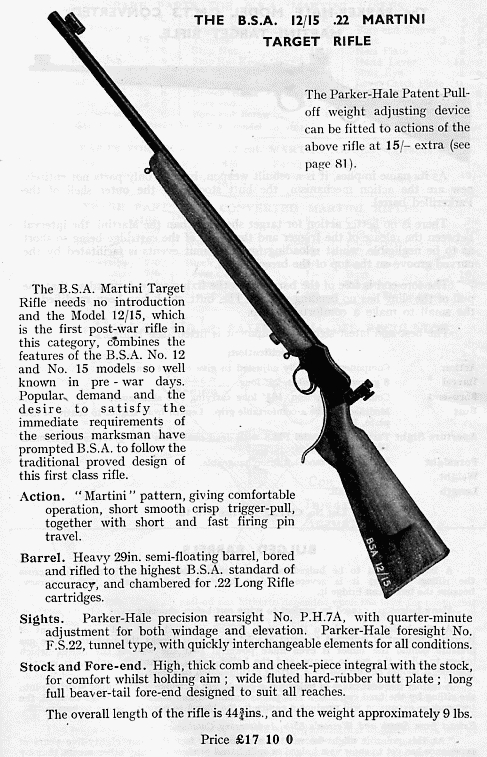 Society
of Miniature Rifle Clubs, was 3 lbs.This was mainly because any attempt
to lower the trigger weight of a Martini action below certain limits resulted
in an unsafe firearm that could be unintentionally fired by only a minor jolt.
As other rifles became available, including the American Winchester
52 and Remington
37 bolt-action target rifle models with fine adjustable triggers, rules
were relaxed and there came a requirement for lighter triggers on the old Martini
target rifles
- simply as a post-war ( 1939-45) economic expediency.
Society
of Miniature Rifle Clubs, was 3 lbs.This was mainly because any attempt
to lower the trigger weight of a Martini action below certain limits resulted
in an unsafe firearm that could be unintentionally fired by only a minor jolt.
As other rifles became available, including the American Winchester
52 and Remington
37 bolt-action target rifle models with fine adjustable triggers, rules
were relaxed and there came a requirement for lighter triggers on the old Martini
target rifles
- simply as a post-war ( 1939-45) economic expediency.
Parker-Hale produced a modification to permit trigger adjustment. This was only available as an 'in-house' alteration and required just the posting of the easily removed action to the factory. Quite a number of Model 12/15 and 15 rifles will be found to have been fitted with this comparativly simple after-market spring weight adjustment. To make any adjustment properly, it was still necessary to remove the action from the rifle, drift out the falling-block and extractor fulcrum pins, make the adjust with the now accessible slotted screw, and reassemble. Obviously, if the weight was still not to the shooter's liking, it was necessary to repeat the process. Whilst perhaps a rather tedious process, it did at least offer a safer, easier and more reliable way of adjusting pull-off.
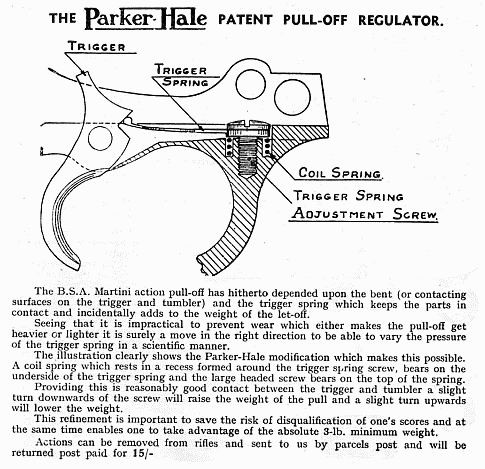
See page on the .22 MARTINI and the LEE_ENFIELD TRIGGER PULL
The vital statistics quoted in 1940 for the Model 12/15 were as follows:
Length of barrel: 29 inches
Length Overall: 44 inches( interestingly, this shows as 44¾" post war)
Length of stock from trigger: 14¼ inches
Length of fore-end: 16 inches
Weight: 9¼ lbs.
It can be seen that, on its introduction circa 1935, the standard rifle was priced at £7-17s-6d, and thirty shillings more, at £9-7s-6d, with the Centurion barrel supposedly guaranteeing 1½ inch groups ( but it is not noted at which range!).
By 1940, these prices had risen to £8-12s-6d and £11-0s-0d repectively. Post-War the standard rifle had almost doubled in cost to £17-10s-0d.
The rifle was still offered in the 1951/52 catalogue, but was missing from that of 1954, but would still have still been available with retailers around the country, not least because the last of production is reported not to have left the factory until around the middle of the decade, although, obviously, not all production was destined for the home market.
Below we reproduce an article written by Dave Parish for target Gun, Nov/Dec 1979. Reproduced here with his kind permission.
CLUB GUNS- 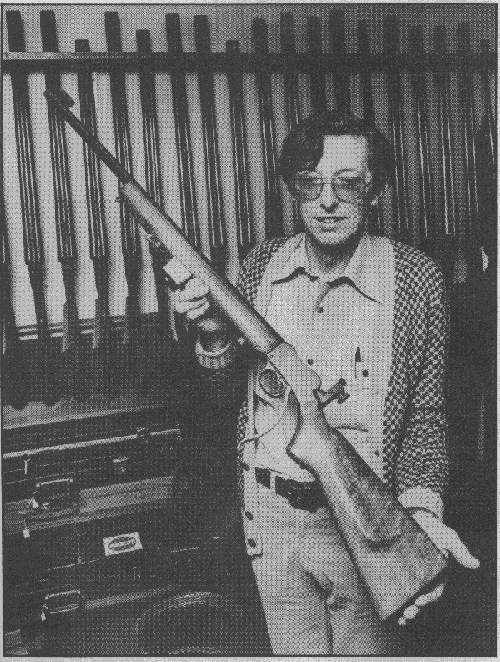
 We found this example of the BSA 12/15 in a gunshop and, although
it had been privately owned, it proved ideal to illustrate avid
Parish 's points about the club 12/15.
We found this example of the BSA 12/15 in a gunshop and, although
it had been privately owned, it proved ideal to illustrate avid
Parish 's points about the club 12/15.
It was basically in good condition, but required a few detail points of attention as outlined in the article.
"How those old 12/15s can live again."
By DAVID PARISH
CALLED many things, some not very complimentary, the club rifle is generally
referred to as the "Club Gun". As in very many cases this rifle is
a B.S.A. 12/15, or one of the various Martini actioned B.S.A. rifles from which
the 12/15 was derived.
A little history for the younger members of our sport: time was before the Second
World War when if you used a British-made rifle it would most likely have been
a B.S.A. or a Vickers, whilst the "Club
Gun" was a Martini; converted from full-bore.
The majority of the B.S.A. rifles were the Model
12 which, according to the advertisements of the time, had "Consistent
accuracy, perfect balance and ease in loading"--"The Champion's Rifle".
It then went on, "Add to these the remarkably long life of the weapon,
the low prices--with open sights five pounds, or on Easy Payment Terms 12 monthly
instalments of 9/4d.... That's enough, and unless compared to the average wage,
prices don't mean very much.
The "remarkably long life" was very true and many are in use today,
along with the No 8, a lighter
model with 25 in. barrel and the No.
13 with 25" barrel but lighter still at 6 Ib 7 oz. The No.
15 had an action body with the rearsight mounted directly on a dovetail
cut in the rear of the body, a pistol grip stock and a long forend. Parker-Hale
also would fit a new lever, pistol grip stock and if required, the long forend
to the B.S.A. No. 8 or No. 12.
Some time in late 1935 or early 1936 Parker-Hale Ltd. offered the B.S.A.- Parker
12/15, and so this best-known of all British club rifles came into being. It
was continued in production by B.S.A. after the war, finally being superseded
by the B.S.A. version of the Al Freeland "Super Rifle" known as the Martini International.
Is the 12/15 competitive nowadays? If you mean in the highly competitive
sport of prone shooting, no of course it is not, but if you refer to its
use as a rifle to teach beginners or for those who prefer shooting as a
recreational sport and to whom high scores are pleasing but not primary,
it has no equal at its price.
Can it be improved? Taking into account up to date techniques - certainly,
and at little cost, and I will give you a few ideas as we proceed. However
the biggest failing of those that I have observed is neglect.
"Inner cleanliness comes first", so a well known advertisement says;
so when was the last time your club rifles were cleaned, with solvent and if
necessary a bronze brush? This year, last year, sometime - NEVER? The Martini
action is very easy to clean, and also gets very dirty in areas where we don't
want dirt.
Now let us look at the typical club 12/15. Is there anything that can be
removed from the rifle before we add anything to it? Ah ha!--a two point
sling!
Very nice for carrying the rifle over your shoulder but not much good for anything
else. Take it off and hide it where nobody is likely to find it in a hurry.(Not
in 21st. Century historic Service, Classic Veteran Classes you don't! - website
Ed.)
A quick loader?, for those who do not know, a device attached to the side of
the rifle to hold cartridges. I used to think they were all right, but learnt
that they were a nuisance 25 years ago. (They still are a further 20 odd
years on - Ed). If there is an ancient handstop with a strap over the barrel
throw it away or give it to the chap who looks after the club archives. Any
frontsight elements of 3.0 mm or below; no good for our present TARGETS
. (All
still excellent advice - Ed).
I do not intend to to into any detail that requires skill to effect a repair
as that would be out of the scope of this article, but let us proceed to
remove the action from the rifle and the buttplate from the butt. Gee-whiz,
still got one of those rubber boots over it? Give it to the chap in the
last paragraph who had the handstop.
Now remove the forend from the barrel. Using a long screwdriver ensure that
the butt Is securely fitted by tightening the stock bolt. It should now
be impossible to move it. If, however, it is still loose see if a few washers
under the stock bolt head do the trick or see if the stock is loose in the
socket in the action body. If so, it can be built up by using "Devcon"
or similar. Most only need the stock bolt tightening - a loose butt is not
at all helpful to accurate shooting.
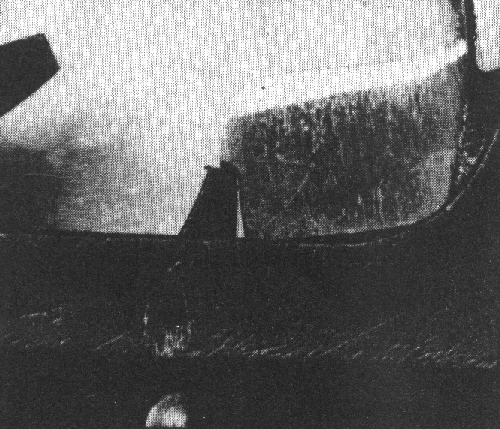 With the mechanism cocked you can
With the mechanism cocked you can
check the trigger sear engagement Make
sure it hasn 't been stoned almost out of
existence and, above all, check that the
firing pin does not fall when the action Is
closed sharply. Without expensive
modifications, you can't get the trigger
pull much below the old standard of 3 Ib.
Place the barrel in the padded jaws of your vice and, using a bronze bristle
brushand a solvent such as Hoppes, give the barrel a good scrub. The brush
wont hurt the barrel at all. Pass a couple of clean patches through to remove
the loosened fouling and look at the bore. You will probably be pleasantly
surprised at how good it looks.
Then look at the muzzle under a strong magnifying glass. Look for any burrs
or nicks. See if you can observe any damage to the barrel inside for an
inch or so back.
If there is a nick or burr at the muzzle or any cord wear from a pull-through,
then this must be seen to by somebody who knows what they are doing. If
there is any wear at the muzzle it should be shortened and recrowned. The
average firearms dealer may not be skilled enough to do this but should
know of somebody who 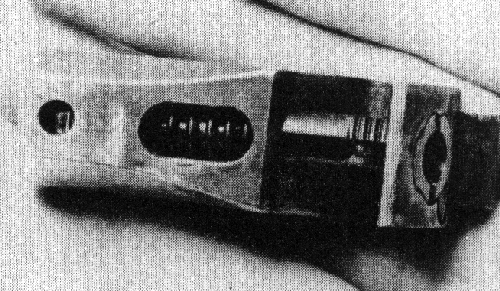
The firing pin and spring mechanism as
viewed from the underside of the breech
block. The internal mechanism is
removed by unscrewing from the rear.
can do a first class job if he is unable to do it himself. Like everything
else it is not difficult when you know what you are doing, but a poor job
can make things worse. If the bore at the muzzle appears satisfactory, go
back to the breech. Fortunately rod wear does not occur very often; partly
because most of them are rarely cleaned but also because the rod is guided
pretty well. On a bolt action rifle rod wear in the lead and on the edge
of the chamber can occur if a rod guide is not used.
Any bad wear in the barrel is expensive to put right, as shortening at the
breech involves a lot of work and if the barrel is this bad it is not worth
spending a lot of money on the rifle, as it could well be more than the
cost of replacing it with another rifle with a better barrel.
If all looks well, clean the inside of the action body and pass a patch
well soaked in solvent through the barrel and store overnight, muzzle down
in a tin to collect anything that comes out. Next day use the bronze brush
again once or twice through the bore and dry with clean patches.
Now that the barrel is clean keep it that way. Before each night's shooting
use a chamber brush and after say 250 rounds clean with an ordinary bristle
brush,
solvent and dry patches. Never leave the barrel dry but fire a few rounds
through it, or clean before the evenings shooting, or oil lightly until
next time when this oil must be dried out.
Look at the breech end of the barrel where it acts as an anvil for the firing
pin. This must not be dented or ignition will suffer. However the metal
may be able to be peened to repair the damage. Possibly someone in the club
is skilful enough, but if in doubt get someone who knows what they are up
to. If there is an indent this indicates a too-long firing pin at some time
and perhaps it may still be in.
Take the action apart and thoroughly clean it in solvent. Keep the solvent
off your hands as much as possible as it is not too good for them. If the
firing pin
spring is broken or "tired" replace it with a new one. Examine
the firing pin, ensure that it moves freely in the block and that the protrusion
is correct. This can be checked either with a gauge or against a couple
of new rifles. Very few are at fault, but again adopt a policy of safety
first and do not attempt to alter unless you are absolutely sure you know
what to do.
Reassemble the clean action and observe the trigger and sear engagement,
using a glass. This must be ample for safety as if the angle is incorrect
or engagement insufficient the firing pin can fall when the action is closed.
With the action in the hand close the lever smartly a number of times to
ensure that this does not happen.
These rifles were designed for a heavy trigger pull and without extensive
modifications will not safely go down much below 3lb. If the trigger and
sear are badly worn or more likely stoned out of existence it is simpler
to replace them.
There were a number of modifications available for these rifles to enable
the trigger to be adjusted Some were better than others but In all cases
they were not designed to enable the weight to be reduced, only to provide
easy adjustment of weight, and on some engagement. 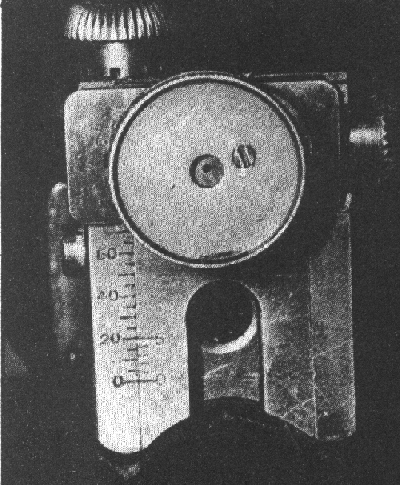
This rear sight was quite tight and smooth
in operation throughout the full range of
its adlustment for both elevation and
windage. "Sloppy" sights can be
tightened by very careful tapping.
*************

unscrewing the knurled ring at the rear.
Owing to the size of present-day TARGETS ,
elements of less than 3 mm are of little
use.
*****************
How about somebody marketing a low-cost conversion for both the 12/15 and Martini
International to enable a safe, lighter two stage trigger to be installed? However
1 believe that costs may be far too high for it to be commercially feasible. (This retrofit basic adjuster was available from Parker-Hale for the models
12 and 12/15, and later a more sophisticated version for the International -
now commonly known as the Mark I. The system was introduced as standard on the
Mark II - Ed).
Replace the action into the rifle and see if the extractor has dropped.
Most are a little low and give the characteristic bulge to the case, if
it is very bad see what is the cause. A combination of wear on its pin,
the screw which holds the action into the body, and the extractor itself
being worn is the probable cause. New pins may effect a partial cure and
certainly the action screw should fit well as this can also lower the strike
of the firing pin.
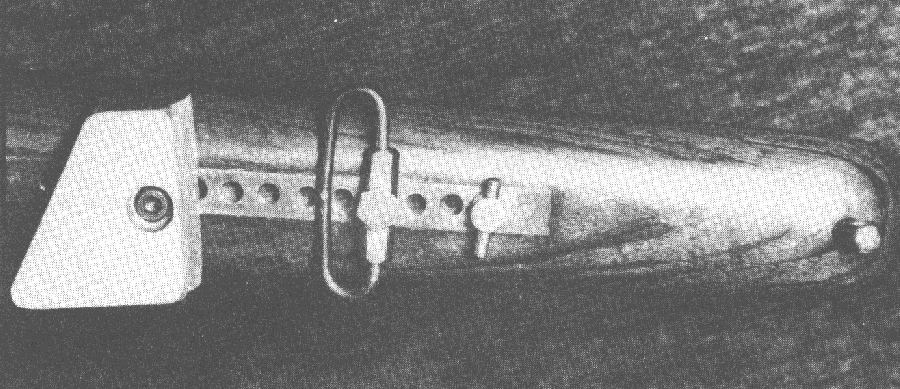 Each shooter should have his or her own element if they do not have a
rifle of their own. For the absolute beginner a foresight can be left in
the rifle which enables, at 25 yds on the centre two aiming marks, the maximum
white to be seen without the other aiming marks intruding. Even this is
artificially small, restricted by the style of card. If the tunnel of the
foresight is shiny it could be oil blacked or even painted with camera black
paint.
Each shooter should have his or her own element if they do not have a
rifle of their own. For the absolute beginner a foresight can be left in
the rifle which enables, at 25 yds on the centre two aiming marks, the maximum
white to be seen without the other aiming marks intruding. Even this is
artificially small, restricted by the style of card. If the tunnel of the
foresight is shiny it could be oil blacked or even painted with camera black
paint.
Rearsights of the folding pattern-and there are plenty of those still left
- are usually pretty badly worn. Most are model 8 and 8a, and these should
be discarded unless funds are very low. Similarly the B.S.A. sights on the
No. 15 should be replaced, although many were replaced by Parker-Hale sights
and a few are still in good condition. They are less easy to tighten that
the Parker-Hale as the dovetail is part of the action body.
A sloppy sight can be tightened by judicious tapping, and experimenting
on a really bad one can give experience. It is not as difficult as it seems
but go slowly, tightening is much easier than loosening the slides when
it has been over-done. If you are unable to do this and the sight is very
bad, a number of dealers, including the N.S.R.A., usually have a selection
of used sights in stock and at low cost.
The local Model Engineering Society can often be very helpful at times like
these, as many of their number have considerable skills. Springs can be
installed to reduce lost motion, and as most of these rifles are used only
at 25 yards it is relatively simple to get the right length over the elevation
and windage screws. Ensure that the sight is rigidly mounted, that it seats
down well, and the screws are tight. If the aperture is O.K. use it. If
not get a l.l mm single hole which will be adequate for almost all needs.
Now for the forend. The number of times shooters used to scratch away at
the barrel channel when they had a bad shoot was amazing, as was the weird
and not 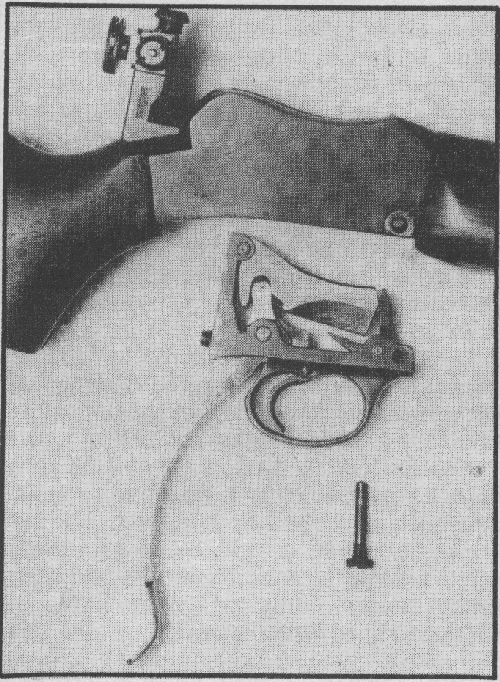 very wonderful packing that was used !
very wonderful packing that was used !
*******
Removing the 12/15 action is simplicity
itself, and you can get this far by taking
out the single screw with a coin. The
action must be cocked in order to get it
out, and the removal of three pins further
strips it into its basic elements.
*********
The wood on 12/15 is pretty well-seasoned now and all that is necessary is to
ensure that it does not bear on the barrel unevenly, and from two inches in
front of the forend screw it can be cleared so that a card can be passed between
the barrel channel and the forend: The rear part of the forend must be a nice
fit to the barrel and this can be achieved by means of coating the barrel with
something that will leave a mark on the wood and carefully removing the high
spots from the wood. Do this until a very good fit is obtained. Glass bedding
could be used, but in this instance working on the wood is so simple that such
additional expense is not necessary and in any case would not be any better
than a good wood job. Make certain that the bushing for the forend screw, does
not touch the barrel and that the attachment screw does not bottom in the hole
in the barrel, otherwise the forend will be loose. Ensure that the rear of the
forend does not bear unevenly or with any force against the action body, in
fact a slight gap will do no harm.
Now for perhaps the most obvious modification to the factory rifle. Inlet the
forend for a either a "T" slotted rail or a metal plate drilled and
tapped for various positions to hold the handstop and/or sling swivel. (in
2005, this is an absolute no! - ed)
The "T" slotted rail is the better of the two but more expensive.
Mount this in front of the forend attachment screw to give adequate adjustment
for all lengths of arm. If a "T" slotted rail is used, a short
filler to prevent discomfort on the hand should be used and both patterns
must be inletted flush to the forend.
**********
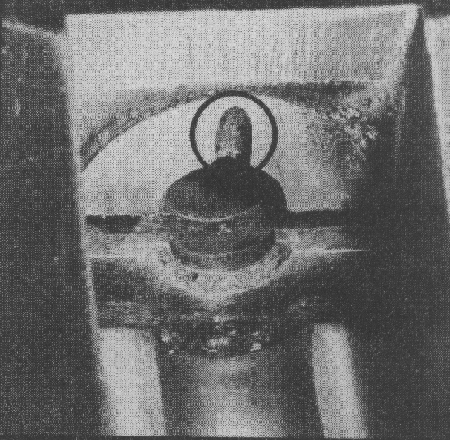 Apart from the presence of a little dirt,
Apart from the presence of a little dirt,
there's not a lot wrong at the breech end of
this barrel. The area that acts as an anvil
for the firing pin (circled) is in good
shape, and the extractor has not dropped
low enough to cause bulged cases.
***********
If a separate handstop is used the sling swivel must be just in front
of the handstop not at the end of the forend. A cheap handstop is a cotton
reel. A round handstop is the logical shape and one of those angled affairs
which is apparently to fit the hand, on closer inspection does not do so
well as the small round pattern.
This adjustment for the handstop and/or sling swivel is a MUST on a club
rifle. As the two point sling has been done away with, a single-point sling
must be obtained and every shooter, even if they do not have their own rifle,
should obtain a sling. The exception of course is the absolute beginner
and there are a number of slings on the market of simple pattern which are
suitable for club use. Ensure that it conforms to U.I.T. rules. The old
U.S. Govt., so called "Springfield" sling is ideal and is in fact
commercially available.
Trigger shoes are not really necessary. Most of them which have been fitted
to these rifles over the years are flat-faced and do little to improve the
feel of the trigger and although the trigger is a little narrow it is better
without a bad trigger shoe than with one.
The buttplate is still off at this stage and it should be decided whether
there are enough club rifles or conversely enough young members or ladies
in the club to warrant shortening the butt on on or more rifles, as the
factory length is rather long for anybody under 5 ft 8 in. It is of course
a simple matter to cut off one or more "slices" and trim the buttplate
to fit.
Have a look at the buttplate and see if it is badly worn. If necessary recut
the grooves or if it is beyond this obtain some fairly hard rubber and face
this with a thin piece of grooved material such as many of the full-bore
stocks are fitted with. This can then be fitted with the original screws
or glued on.
To refinish the woodwork and the metalwork is of course not essential but
how much nicer, particularly to newcomers, if they find not only an accurate
rifle but an attractive one as well. There are many preparations on the
market and that come with details of how to use them. 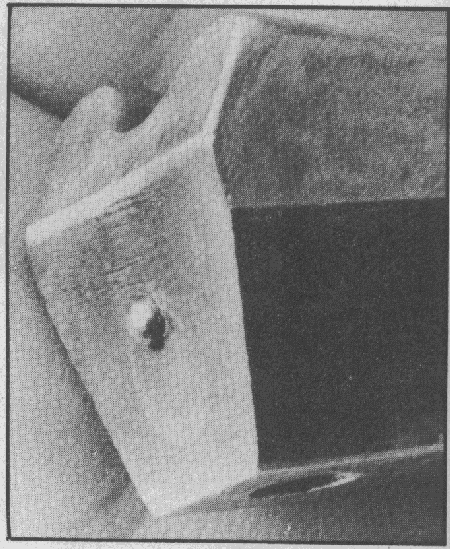
What accuracy should be expected from these rifles? Well, this depends on
what abuse they have had, the work done o put right any faults and the quality
and compatibility of ammunition fed to them. When new some 50 years ago
the best British rifles were guaranteed to give 1 inch groups at 100 yards.
Ammunition has improved considerably since then and as one leading shooter
said: "They had to make better barrels then, as the ammunition was
not so good".
***********
The firing pin protrusion should be
carefully checked. If it is wrong, or the pin
is damaged, or the spring is broken or
tired these parts can be replaced.
************
The barrels were certainly good, not necessarily better than nowadays but
I know what that gentleman meant. A good rifle, tight action and good barrel
with forend bedding as it shold be, will give 1 inch groups at 100 yards
with good ammunition. I have obtained this standard of accuracy from rifles
I have rebuilt whose barrels, on inspection, would not pass as being all
that good. Many of you will be surprised at what fine accuracy is locked
up in that beat up old "Club Gun".
Oh, I nearly forgot: can that unknown gentleman - or should I say gentleperson
- testing this refurbished club rifle shoot 1-inch groups at 100 yards?
That is
another story altogether...
Return to: TOP of PAGE
See this website's Raison d'être